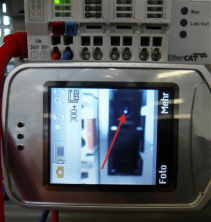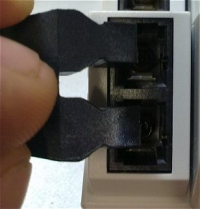Application with EK1521 and EK1521-0010
Application with EK1521 and EK1521-0010
The EK1521, EK1521-0010 is intended for application with optical fiber cables with the following characteristics:
- SC duplex connector
- EK1521: Duplex multimode 50/125 µm or 62.5/125 µm (inner/outer core diameter). The use of both diameters is possible. However, the use of 50/125 µm is recommended due to the lower attenuation.
- EK1521-0010: Duplex single-mode 9/125 µm (inner/outer core diameter). A typically usable cable can be manufactured according to the specification ITU-T G.652.D (0.4 dBm/km at 1300 nm).
 | Recommended connectors The use of SC/PC connectors is recommended for connecting to the EK1521, EK1521-0010. The advantage of the "PC" (physical contact) version of this connector is the crowned end face, which allows the region of the fiber core that is relevant to transmission to be optimally joined when the connector is pushed together. Other versions include, for instance, the SC/UPC (ultra-polish PC), SC/HRL (high return loss) and the SC/APC plug (angled physical contact). An additional feature of these connectors is that light that is reflected by the connector's end face, which is at an angle of about 8° to the fiber axis, is refracted from the core by the cladding glass into the air. This avoids interference with the data transmission, optimizing the core size of the back-scatter. |
 | 50/125 µm or 62.5/125 µm The use of both diameters is possible. However, the use of 50/125 µm is recommended due to the lower attenuation. |
In optical fibers the wavelengths 850 nm and 1300 nm are usually used for data transfer. Commercially available fiber-optic cables are usually optimized for application in one of these ranges, since signal attenuation is frequency-dependent (like in copper cable), so that large ranges of several km can be achieved for the respective wavelength. Fiber-optic cables in the 1300 nm window generally have lower attenuation than cables in the 850 nm window.
In the EK1521, EK1521-0010 a transceiver with the wavelength of 1300 nm is used.
 | Range and bandwidth product Optical fiber cables are available in different qualities from reputable manufacturers. One of the relevant parameters for the user is the frequency-dependent bandwidth product of a cable, specified in [MHz*km]. The greater the bandwidth product, the lower the attenuation, and therefore the larger the range that can be achieved with this cable (see ITU-T G-651). For achieving the maximum range with the EK1521, EK1521-0010, optical fibers with a maximum bandwidth product of 1300 nm should therefore be used; we recommended using class OM2 optical fibers (EN50173:2002). Standard optical fiber cables have a minimum bandwidth product of 500 MHz*km at 1300 nm, higher-quality cables are suitable for distances > 500 m over > 1000 MHz*km. In order to achieve the maximum range, the device to which the EK1521, EK1521-0010 is connected must also support such ranges. |
 | Installation notes
|
Further information can be found in the following documents:
- ITU recommendation ITU-T G.651 - G.655
- EN 50173:2002
- EN 60793-2
Connecting and releasing the optical fiber cable at the junction
Notice | |
Risk of damage to the cable! To disconnect the optical fiber cable always pull the connector to release the locking mechanism - never pull the optical fiber cable itself. |
 | Crossover cables Not that crossover cables may have to be used for connecting the EK1521, EK1521-0010 with the EK1501/ EK1501-0010. |
 | Use of blind plugs To protect the transceiver from environmental influences, unused connection socket should be sealed with the blind plugs provided! |

